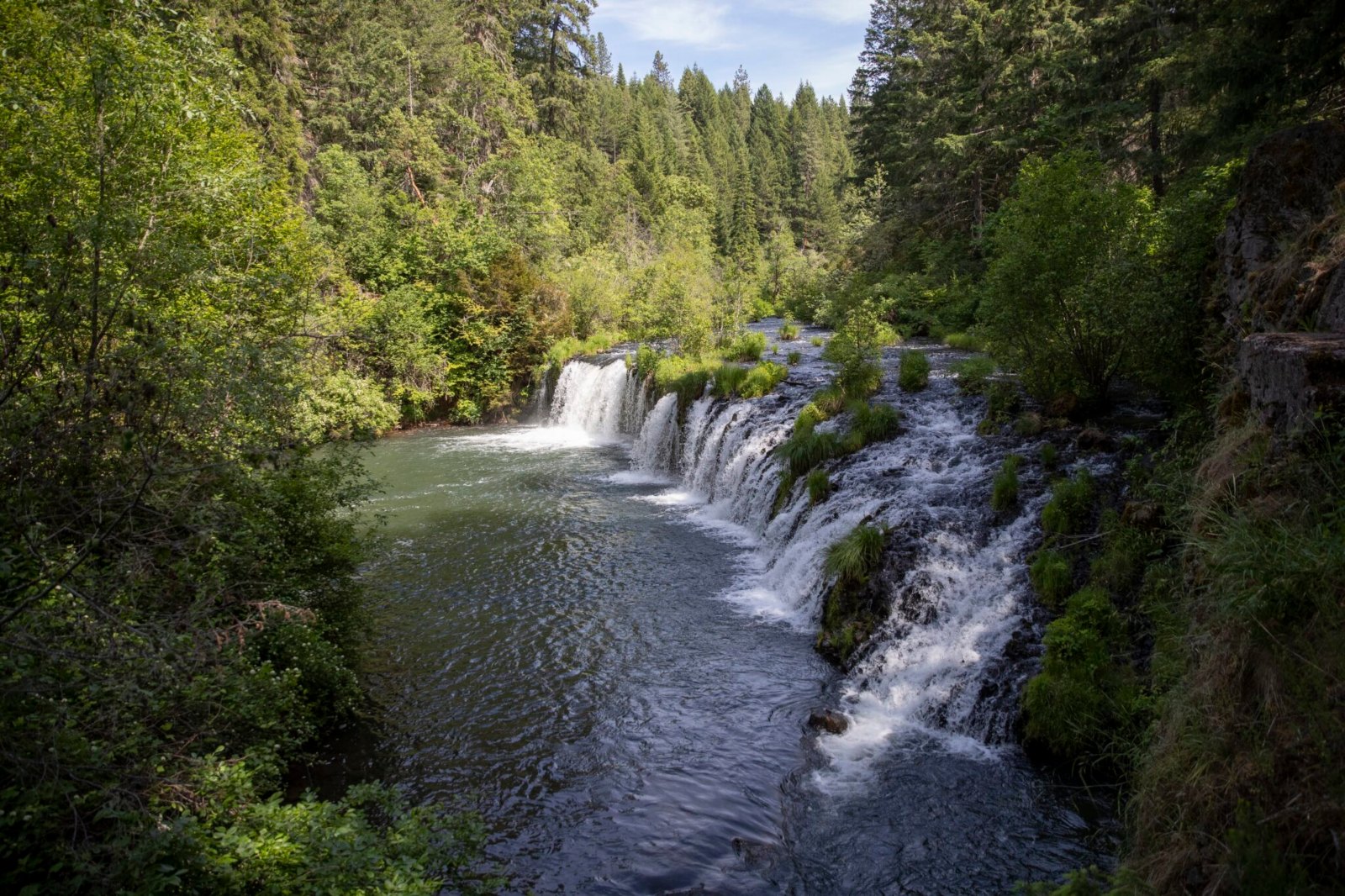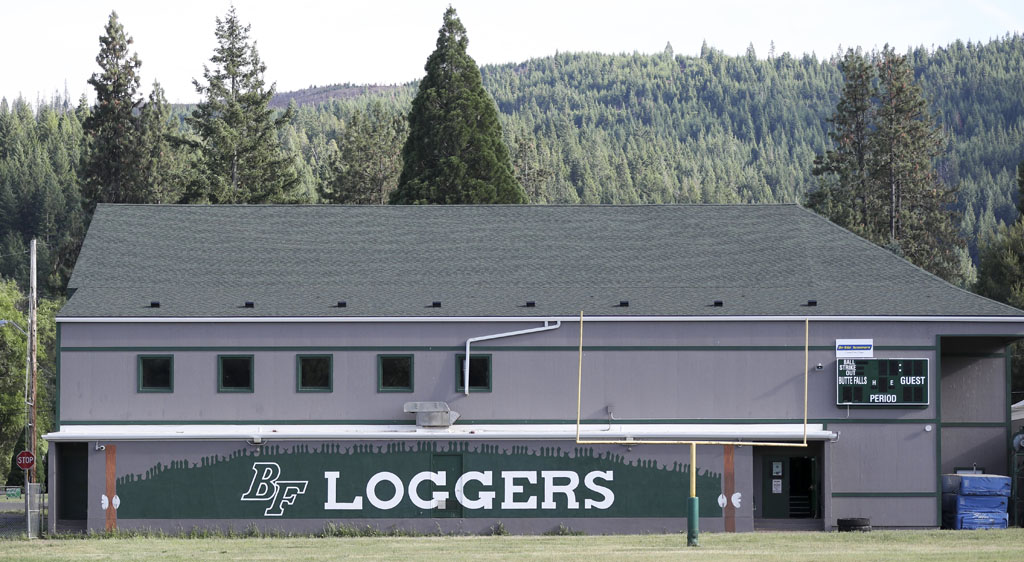A logger, forester and former mayor have joined forces to help Butte Falls protect its town and build an economy supported by tourism
By Grant Stringer / Columbia Insight
With a population of just 400 people, Butte Falls is a speck in an ocean of remote timberland, much of it burned.
The community is tucked into a vast forest of pine and fir about 35 miles from the California border. Outside town, snow-capped Mt. McLoughlin towers above a vast burn scar, where blackened trees from the South Obenchain Fire stand crookedly across miles of the Cascade Range’s foothills.
In September 2020, logger Don Hamann watched with awe as that blaze cast embers over his head in the middle of the night.
Hamann, 70, ignored an evacuation notice to protect his property and that of his neighbors on a woody rise above Butte Falls.
In the light of day, Hamann could see the smoke from a separate fire burning thousands of homes in nearby Ashland and Talent, and further to the north, yet another blaze leveled the mountain community of Blue River.
The Obenchain would burn 33,000 acres and skirted Butte Falls by just a quarter of a mile.
“You can’t stop it,” Hamann recalls. “It was amazing.”
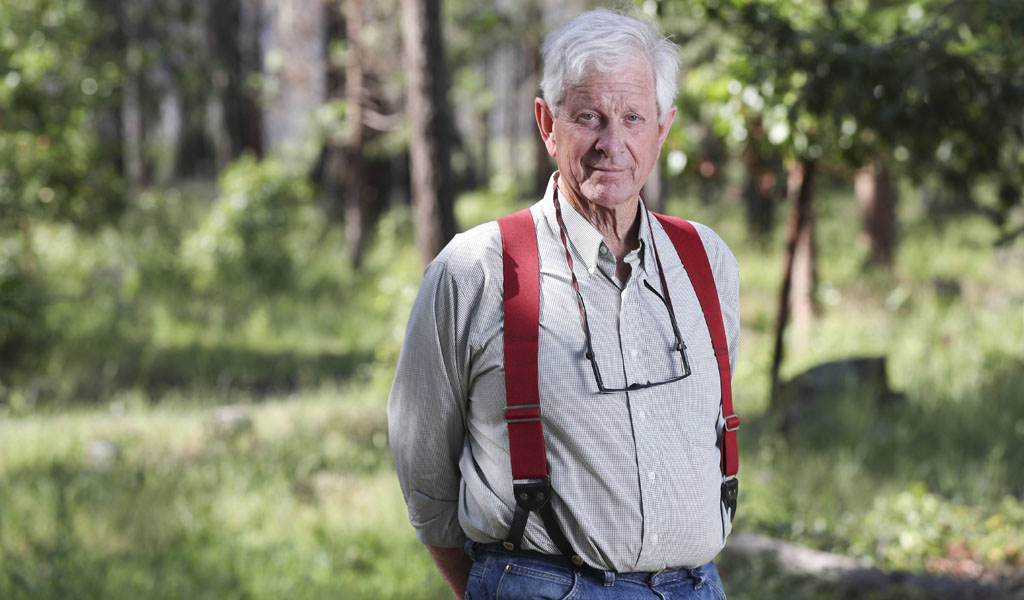
Retired forester Don Hamann is helping bring an unconventional approach to fire defense in Butte Falls, Oregon. Photo: Amanda Loman
Butte Falls residents disproportionately live with disabilities or in mobile homes, risk factors that make it difficult to prepare and evacuate from wildfires that have become increasingly destructive.
The hamlet itself, once a logging powerhouse, is still struggling to provide residents with good-paying jobs more than 40 years after the local timber industry began its long decline. Almost 10% of Butte Falls residents left town between 2010 and 2021.
Conventional wisdom in the region would have Butte Falls try to reclaim its former glory as a logging hub.
But community leaders have hatched an ambitious plan to protect their future by looking to the forest itself as a source of protection as much as prosperity.
The town government recently purchased a ring of privately owned timberland surrounding Butte Falls. Instead of harvesting the land—which could provide an immediate, short-term boon to the town economy—locals want to grow an older and biodiverse forest that they say will better protect the town from wildfires, while attracting outdoor tourism.
Conservationists and the state’s top politicos say the small project playing out in a remote corner of Pacific Northwest forest can teach other communities how to adapt to climate disasters and hard times.
New vision
The 2018 blaze that killed at least 85 people in Paradise, Calif., was a wakeup call for Linda Spencer, who was the mayor of Butte Falls at the time.
At that point, Butte Falls was completely surrounded by about 400 acres of timberland that didn’t have much value for the community itself. Modern timber companies had rejected the practice of sustainable harvesting—low-intensity logging that provided a dependable supply of timber for future generations and, crucially, steady paychecks.
A string of companies since the 1980s intensively harvested parts of the land or let it grow wild, resulting in a dangerously dense and young forest on the community’s doorstep, a serious fire risk, according to Mike Smeltz, a veteran local forester.
Smeltz, Hamann and Spencer shared a new vision for the land. The logger, forester and former mayor believed that, if the town bought the forest, it could thin and burn unwanted foliage to cultivate open groves of old-growth trees resilient to wildfire and drought.
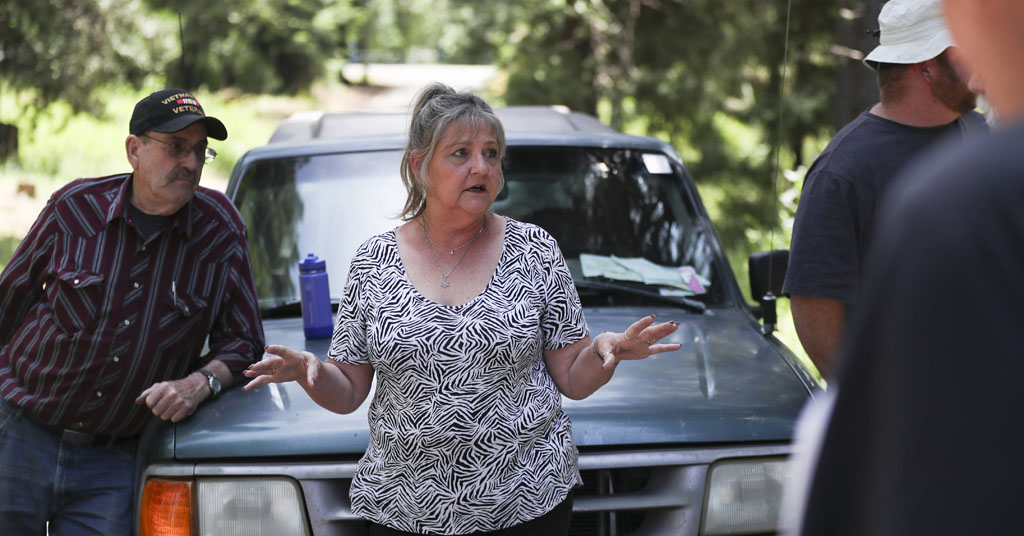
Butte Falls mayor Trish Callahan is building a consensus of locals at regular Community Forest chat sessions. Photo: Amanda Loman
It’s a strategy some environmentalists want to implement across U.S. forests to sequester carbon, promote biodiversity and blunt severe wildfires—and one recently planned in Paradise itself as it rebuilds in California.
In the new Butte Falls Community Forest, local foresters could build a trail network and recreation amenities near a roaring waterfall to bring outdoor tourism to town, providing incomes without relying on dwindling timber jobs.
For Hamann, who has decades of experience in sustainable forestry projects, a beautiful forest is a more valuable asset in the long run than the timber from a clear cut, particularly if it’s your backyard.
Spencer, the former mayor, sees the project as a way for the community to assert control of a resource that is critical to the town’s future and the quality of its environment.
“The idea is, we didn’t want someone else managing the forest around us,” she says. “We wanted to manage it ourselves.”
When the Seattle-based timber giant Weyerhaeuser informed the Butte Falls City Hall of plans to clear-cut and sell the cleared parcels surrounding the town, likely to another timber company, Spencer jumped at the opportunity to create a community-owned forest instead.
The town purchased the 400-odd acres of woods last year for about $1.1 million with assistance from the Trust for Public Land, a conservation nonprofit. The cost was entirely covered by grants and donations, mostly from the Oregon state government and the U.S. Forest Service.
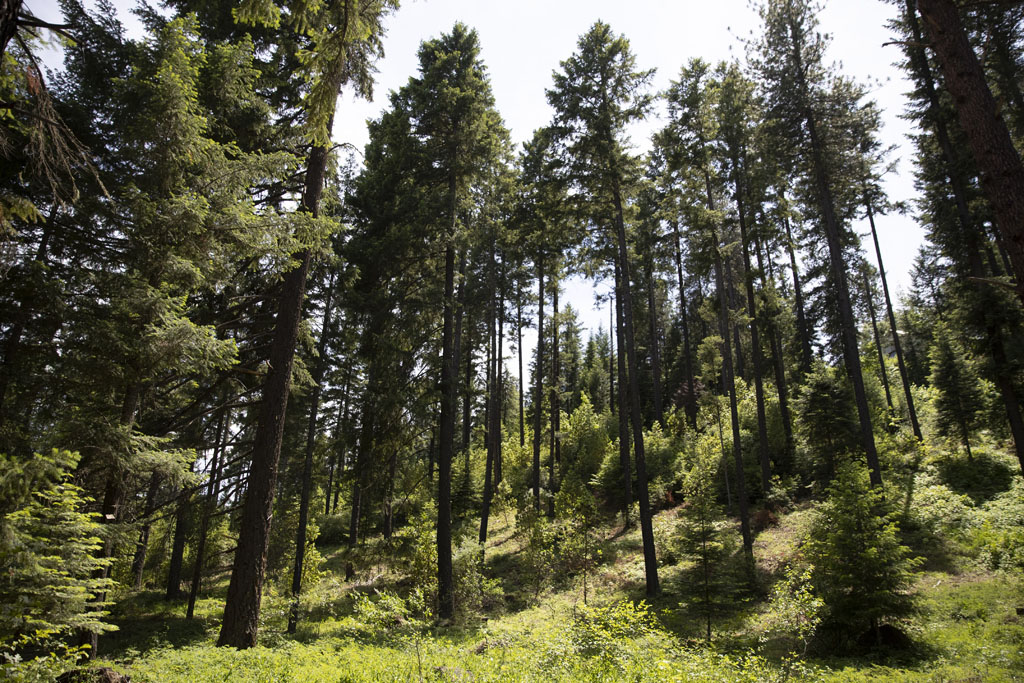
This stand of 100-year-old Douglas fir in the Butte Falls Community Forest had the underbrush thinned earlier this year. Photo: Amanda Loman
Hamann and several experts told Inside Climate News that Weyerhaeuser is dropping assets in much of southern Oregon because of climate-driven tree die-offs and wildfires, which would mark another notch in the industry’s decline.
A spokesperson for Weyerhaeuser declined to comment for this story.
New climate, new perspective
Destinies in Butte Falls were always linked to the forest.
The Butte Falls Sugar Pine Company built a sawmill and platted the town in 1906, according to historian Jeff LaLande. The firm took its name from the giant conifer of high cultural and religious value for the Achomawi people.
Loggers prized sugar pines for their smooth, straight timber.
In the 1980s, a Texas millionaire gutted the company that for decades had provided steady employment in Butte Falls. Almost all prized timber was cut and the mill sold, LaLande writes.
Smeltz, 68, moved to Butte Falls in the 1970s and watched the company’s liquidation plunge the town into a deep economic decline that it never truly recovered from, the forester said.
It’s a familiar story across the Pacific Northwest.
“People didn’t have good jobs anymore,” he said. “When I came to town, the tavern was rockin’, alcohol was the drug of choice. Now, heroin is the drug of choice. Now it’s fentanyl.”
Smeltz embarked on a 40-year career in forestry, including 28 years with the U.S. Forest Service.
While Butte Falls changed, Smeltz watched the forests change around him. The climate in southern Oregon turned dry and hot, consistent with projections of human-caused climate change.
Firs in the region are dying en masse due to drought and insects, pock-marking the green forests of the Cascades with brown sores that easily burn, Columbia Insight reported. Douglas firs, the state tree, which is high-value timber, are being replaced by species that are more resilient to drought.
Climate science is unpopular in Butte Falls, which is staunchly conservative, Smeltz says. But when a group of locals visited the new community forest on a recent Saturday, there was broad agreement that the climate is less hospitable for certain conifers than it once was.
Hamann had convened the meeting with a handful of residents as part of his weekly “forest chats,” where he describes his vision and seeks community buy-in over the roar of the falls.
On the warm afternoon, Hamann drew the group’s attention to a grove of century-old firs and pines. It’s the only mature forest remaining in the town-owned parcels and the first portion that would age enough to provide the biodiversity and wildfire resilience he envisions.
But much of the forest encircling Butte Falls is made up of young “ladder fuels,” a term in fire ecology for mid-sized foliage and low limbs that spread fire from the forest floor up to the canopy, where it is impossible to smother.
The town wouldn’t stand much of a chance if the forest around it burned in its current state, Stan Moore, another local retired from a career in forestry, told the others, who nodded grimly.
If Butte Falls can weather this fire season, Smeltz will lead efforts to thin the forest by cutting down young trees and deadlimbs, which will be piled and burned. That will help the largest trees, including mighty ponderosa pines towering above the thicket, to continue flourishing. The town already secured $450,000 from the Oregon Department of Forestry and another $450,000 from the Federal Emergency Management Agency for this work, according to Smeltz.
The community has partnered with Chris Adlam, an expert on prescribed burns with Oregon State University, to reintroduce low-intensity ground fires as often as once a year to mimic the natural fire cycle in the forest and further reduce the dangerous overload of woody fuels, he says.
Inside the town borders, Butte Falls is removing dangerous vegetation and ignition sources as part of the national Firewise USA network.
Mayor Trish Callahan said more work and education is planned to help prepare residents for the next wildfire.
“The future of natural resources”
When he grew up in Cottage Grove, an Oregon community rocked by the so-called timber wars between loggers and environmentalists in the 1990s, Kelly Droege watched disagreements over land management turn nasty, pitting residents against each other.
Droege obtained a Master’s degree in forestry from the Yale School of the Environment and in 2018 founded Chinook Forest Partners, which manages 215,000 acres for timber companies in Oregon and Washington. The company’s portfolio briefly included the ring of forest surrounding Butte Falls.
He thinks deeply about the relationships rural communities have with forests and views Butte Falls as a case study in striking a balance between new and old ideas.
“This is the future of how we view management of natural resources,” says Droege.
When she was in office, former Gov. Kate Brown, a Democrat, visited Butte Falls and designated it part of Oregon Solutions, a statewide policy network that fosters community-based solutions to thorny problems like high unemployment and wildfire danger. The state’s Democratic U.S. Sen. Jeff Merkley penned a letter expressing his support for the community forest and his staff have walked its stands of fir and pine, says Smeltz.
The project resonated in high places in part because of political acumen on the part of Spencer, the former mayor, who worked in the Environmental Protection Agency and the United Nations before retiring to Butte Falls.
Owen Wozniak, a program manager at the Land Trust Alliance, lauded Butte Falls’ work. But he said Spencer’s political connections and assistance from the Trust for Public Land make its example somewhat unusual.
“Most small communities just can’t access the resources and lack the financial and human capital to tackle such things,” he says. “There are thousands of communities across the West who need similar efforts. So it’s exemplary, but still too limited.”
Nonetheless, plans like those in Butte Falls are playing out across the region, from nearby Ashland, which has its own community-based model of fire adaptation, to Washington State as foresters and economic development experts push for new solutions in at-risk communities.
Nationally, there’s an excitement among conservationists and climate advocates that rural areas can leverage public lands to keep their communities functioning and safe from the most immediate hazards posed by the climate crisis. Towns have taken ownership of forests in Montana, Virginia and Vermont for a range of purposes, including wildfire resilience, but Butte Falls’ approach is “pretty unique,” says Chris Dunn, an associate professor in Oregon State’s College of Forestry.
Butte Falls also benefits from the brain trust of Hamann, Smeltz, Moore and others who spent decades in forestry and logging.
And Dunn said it’s rare that a community can legally buy all the land immediately around it. Towns in fire country often abut public or tribal land or are constrained by an urban growth boundary, he said.
But Dunn said the work in Butte Falls to prevent homes from igniting, coupled with adequate management in the community forest, could offer significant protection to the town in future fire seasons.
After the community meeting, Hamann took a walking stick in each hand and traversed a section of the Obenchain Fire burn scar on a rise above town. Lupines and Indian paintbrush poked out of a dense understory that sprung up after the blaze. Above, massive sugar pines and incense cedars stood blackened as high as 50 feet up their trunks. But they were still alive.
“This stand right here survived about as tough a condition as you can possibly survive,” Hamann said.
His hope is that Butte Falls can become just as resilient.
FEATURED IMAGE: Butte Falls, with community forest on either side of Big Butte Creek, a tributary of the Rogue River. Photo: Amanda Loman
This story was produced by Columbia Insight in collaboration with Inside Climate News, a nonprofit, independent news organization that covers climate, energy and the environment.

